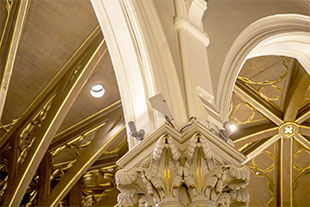![]() The completion of a US$26m restoration at the 150-year-old Cathedral of the Holy Cross in Boston gave New England-based integrator Commlink the opportunity to showcase its prowess with wireless in worship spaces.
The completion of a US$26m restoration at the 150-year-old Cathedral of the Holy Cross in Boston gave New England-based integrator Commlink the opportunity to showcase its prowess with wireless in worship spaces.
Chris Regan, co-founder and President of US wireless audio systems specialist RF Venue, digs into the workings of a well-engineered multi-zone wireless microphone system.
An architectural tour , the 2,000-seat Cathedral of the Holy Cross is the largest cathedral in New England, and surpasses St Patrick’s in New York City in size. This poses a challenge in configuring a ‘works everywhere’ wireless microphone system. Undeterred, Landry Audio – a division of CommLink Integration – took on the project.
 Multi-zone wireless microphone projects – sometimes referred to as DAS, short for Distributed Antenna System – are unique in the world of wireless audio. These projects don’t often have a very high channel count, so it sounds as if it should be easy…
Multi-zone wireless microphone projects – sometimes referred to as DAS, short for Distributed Antenna System – are unique in the world of wireless audio. These projects don’t often have a very high channel count, so it sounds as if it should be easy…
But those mics need to work reliably across a massive floor plan, well out of range and line-of-sight for any single set of receive antennas. And, naturally, the 150-year-old architecture and strict aesthetic limitations of the Cathedral of the Holy Cross added still further to the challenge.
While determining coverage areas and antenna type may require some trial and error, the actual wiring for a multi-zone system at the rack-end is pretty straightforward. In this case, an RF Venue 4 Zone antenna combiner serves as the ‘head end’ of the system, combining each A and B diversity channel down to a single A and a single B. This output pair then connects to an RF Venue Distro4 antenna distribution system (with cascade) or other multichannel antenna distribution system, which then feeds the inputs on the wireless mic receivers
Based on the location of the A/V rack (inside a closed office area) – an estimation was made over practical multi-zone coverage for the wireless system, taking into account antenna type, placement and optimal line-of-sight conditions that would meet the strict aesthetic requirements of the project. Coaxial cable run length vs RF over fibre distribution was also considered.
A pair of low-profile Shure UA864 antennas were mounted on the wall of the altar area, out of sight from the congregation, this section of the cathedral comprised Zone 1, and had an effective range just to the edge of the altar, which is where Zone 2 picks up coverage.
 Zone 2 begins in the transcept area and uses a white Diversity Fin antenna. From a single point of installation high up on the wall of the cathedral (and cleverly camouflaged), the polarisation diversity antenna system is nearly impossible to find, even if you’re looking for it. Over larger areas, particularly indoors with a variety of reflective surfaces, like the marble floor of the cathedral, signal fades due to angle and orientation of the signal are even more pronounced. This is where the Diversity Fin excels in maintaining adequate signal level due to cross-linear polarisation fading
Zone 2 begins in the transcept area and uses a white Diversity Fin antenna. From a single point of installation high up on the wall of the cathedral (and cleverly camouflaged), the polarisation diversity antenna system is nearly impossible to find, even if you’re looking for it. Over larger areas, particularly indoors with a variety of reflective surfaces, like the marble floor of the cathedral, signal fades due to angle and orientation of the signal are even more pronounced. This is where the Diversity Fin excels in maintaining adequate signal level due to cross-linear polarisation fading
The largest area in the cathedral, the main congregation, is where Zone 3 picks up the roving mic transmitters. Here another Diversity Fin in white was installed high up on a column. For certain church services, the microphone transmitters will move down the long walls of the cathedral, and the system would need to reach areas well out of reach of the first two zones. There was a chance this area may require a fourth zone, so Commlink budgeted a backup plan to further extend the system with another Diversity Fin antenna if needed, which would then likely require an RF-over-fibre solution (like RF Venue’s Optix antenna distribution system) due to the 2,000ft potential cable run to the rear of the cathedral. Having thoroughly tested the three zone coverage areas after installation, the 3three-zone configuration was deemed adequate. The Zone 3 Diversity Fin also employed in-line amplifiers to boost the signal and makeup the signal loss over a run of several hundred feet of RF Venue RG-8X cable. These in-line amplifiers are powered by DC on the coaxial lines provided by the 4 Zone.
Tapping into each zone with a spectrum analyser, while walk testing the transmitters set to various power levels (low to high) is an effective way to measure coverage. This particular setup seems to work with the ULX-Ds set to 10mW, but may benefit to moving up to 20mW given the large size of the facility. Happily, the spectrum conditions at the site provide for a low noise floor, and lower transmit power levels work – and save battery life.
The final handoff of the system was completed, along with documentation for the frequency settings, backup frequencies and other system details.
More: www.rfvenue.com